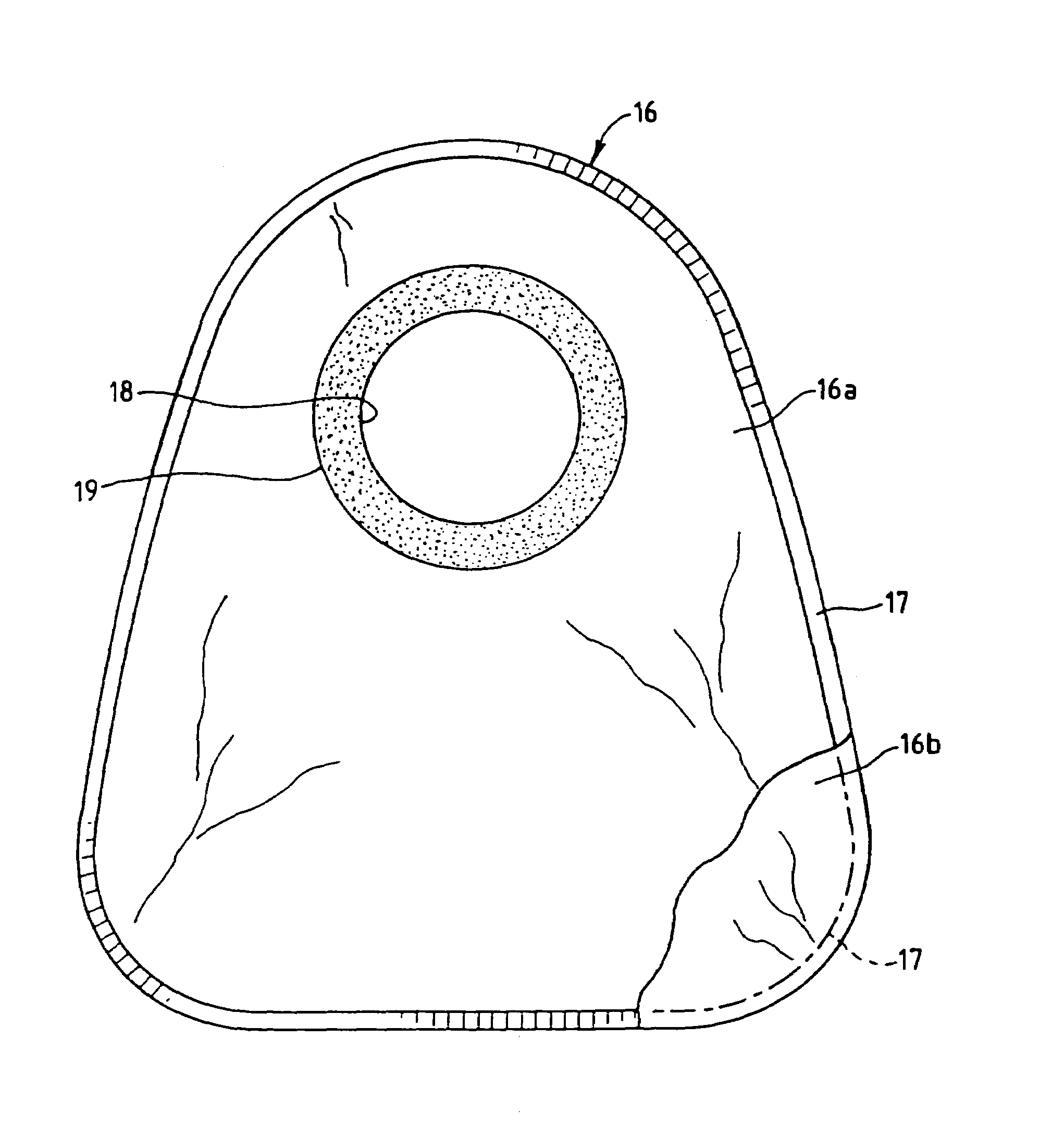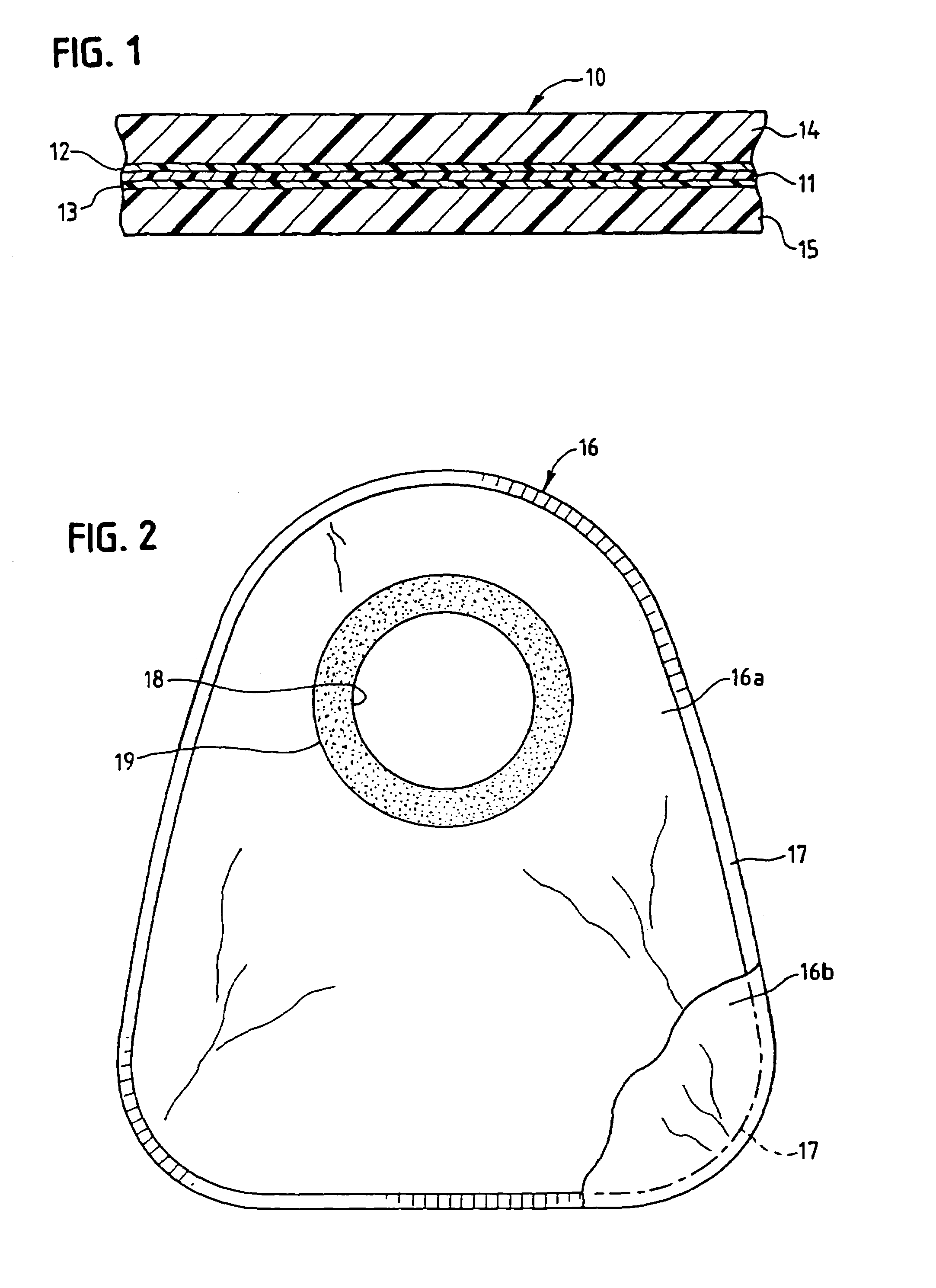Multilayer chlorine-free film with barrier layer of a polyamide blend and ostomy pouches formed therefrom
a chlorine-free film and polyamide blend technology, applied in the field of multi-layer chlorine-free film with polyamide blend barrier layer and ostomy pouches formed therefrom, can solve the problems of affecting the safety of users, so as to avoid embarrassment for users, reduce noise, and good odor barrier properties
- Summary
- Abstract
- Description
- Claims
- Application Information
AI Technical Summary
Benefits of technology
Problems solved by technology
Method used
Image
Examples
example 1
[0026]This example illustrates the properties of blends of amorphous nylon (Selar PA3426, DuPont Company) with anhydride-modified polyolefin (Fusabond MN493D, DuPont Company). The two resins were compounded and pelletized using a twin screw compounder extruder. The compounded resins were then coextruded using a Killion extruder into a A / B / A three-layer film structure, wherein A was polyethylene and B was the nylon blend. Because of the absence of tie layers, it was possible to strip the polyethylene skin layers A from the nylon blend layer B and to test the resulting monolayer B films against a monolayer film consisting of 100% amorphous nylon (Selar PA 3426). Secant modulus at 2% elongation of the monolayer film was measured in the machine direction according to ASTM D882-97 at a strain rate of 0.1 in. / in.min. Results are shown below in Table 1:
[0027]
TABLE 1Monolayer Film Composition%SecantSelar PA3426Fusabond MN493DModulus psi1000323,5008515235,6007525190,000
[0028]The data in Tabl...
example 2
[0029]A five-layer film was produced in accordance with this invention by coextrusion casting, resulting in a film with a total thickness of 3.3 mil and a barrier layer thickness of 0.32 mil. The film structure was A / B / C / B / A, where A was a polyethylene-based resin (Exact 8201, Exxon Chemical Co.) modified by the addition of 5% of a slip / antiblock concentrate (EXT4226TSE, A. Schulman Co.) and 3% of a low-density polyethylene (LD200.48, Exxon Chemical Co.). B are tie layers consisting of anhydride-modified ethylene vinyl acetate copolymer (Bynel 3861, DuPont Co.), and C is a blend of amorphous nylon (Selar PA3426) with an anhydride-modified ethylene octene copolymer (Fusabond MN493D) at 85% to 15% weight ratio.
[0030]The film was tested for quietness by forming a 4 inch by 4 inch sample into a cylinder and mounting it on a test fixture wherein one end of the cylinder was held fixed and the other was rotated around the cylinder axis at an angle of 15 degrees at 70 cycles per minutes. No...
example 3
[0033]A five-layer film was produced in accordance with this invention by coextrusion casting, resulting in a film with a total thickness of 3.2 mil and a barrier layer thickness of 0.28 mil. The film construction was A / B / C / B / A, having the same composition as the film of Example 2 except that the tie layers B were polyethylene-based (Bynel 41E557, DuPont Co.). The film was tested for quietness as described in Example 2. Results are shown in the table below which includes a control sample of a commercial ostomy film having a chlorinated barrier layer of PVDC.
[0034]
TABLE 3SampledBAdB, 8 kHzdB, 16 kHzFilm of Example 3655145Control Film745549
[0035]As in Example 2, the dBA and dB values at 8 and 16 kHz reveal that the film sample of Example 3 is considerably quieter than the control sample in which the core layer is PVDC.
PUM
| Property | Measurement | Unit |
|---|---|---|
| density | aaaaa | aaaaa |
| total thickness | aaaaa | aaaaa |
| total thickness | aaaaa | aaaaa |
Abstract
Description
Claims
Application Information
 Login to View More
Login to View More - R&D
- Intellectual Property
- Life Sciences
- Materials
- Tech Scout
- Unparalleled Data Quality
- Higher Quality Content
- 60% Fewer Hallucinations
Browse by: Latest US Patents, China's latest patents, Technical Efficacy Thesaurus, Application Domain, Technology Topic, Popular Technical Reports.
© 2025 PatSnap. All rights reserved.Legal|Privacy policy|Modern Slavery Act Transparency Statement|Sitemap|About US| Contact US: help@patsnap.com


